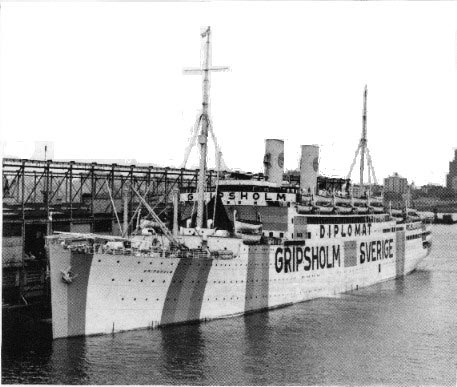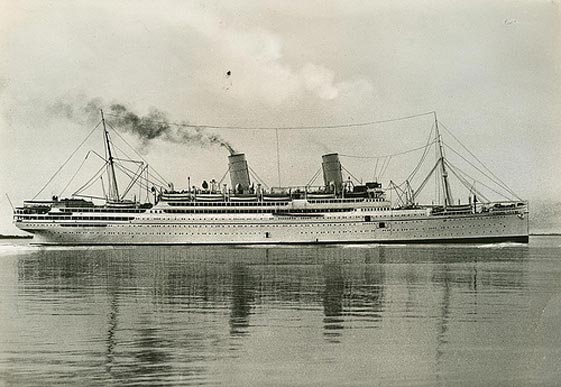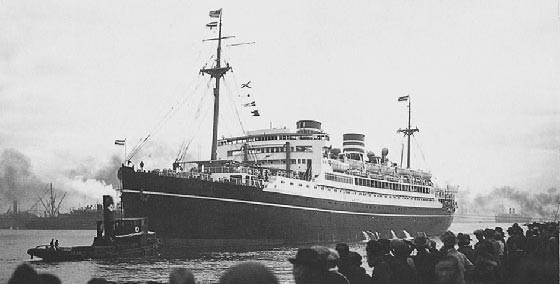
MS Gripsholm
Captain Kuhne and Repatriation of Americans from Japan, 1942
SS Express, a C3-E operated by American Export Lines was sunk in the Indian Ocean on June 30, 1942 while en route from Bombay, India to Cape Town, South Africa by I-10, a Japanese submarine. Aboard were 38 mariners and 17 Armed Guard. The Express carried 4,500 tons of cargo, including manganese ore, mica, jute, hemp, leather, and burlap.
Two torpedoes struck the ship just seconds apart. The ship sank within 8 minutes, and since the ship was still underway as two lifeboats were launched, one of the lifeboats with 11 crew and 2 Armed Guard aboard was swamped, and all were killed.
Captain William Kuhne was the last to abandon ship. He jumped overboard and clung to an overturned boat until he was rescued by one of the other lifeboats. One crewman abandoned ship on a raft, found a water-filled, empty lifeboat and was rescued in 10 days. A lifeboat with 41 survivors including the Captain, landed on the coast of Mozambique 6 days after the sinking, and eventually the men were taken the 200 miles to Lourenco Marques, Portuguese East Africa (Mozambique).
As the small Portuguese freighter carrying the survivors docked in Lourenco Marques, Captain Kuhne was greeted by old acquaintances, John MacGowan and Bob Nicol from the American Export Lines office in New York. The two company representatives helped Captain Kuhne contact the American consul, Austin Toe Preston, who found accommodations for the survivors.
MacGowan and Nicol asked Kuhne to help them make arrangements for the exchange of American civilians caught in Japan for Japanese nationals, including diplomats, who were in the United States on Pearl Harbor day. The exchange was to take place in Lourenco Marques, a neutral port, nearly midway between America and Japan. The MS Gripsholm, sailing under the auspices of the International Red Cross, with a Swedish captain and crew, had been chartered by the U.S. State Department. The ship left New York with 1,500 Japanese aboard. At the same time, the SS Conte Verde, an Italian ship chartered by Japan, was carrying 600 Americans, and the Asama Maru, carrying 900 Americans, left Yokahama.

MS Gripsholm

SS Conte Verde

Asama Maru
The task ahead of the three men was a tricky one: how to transfer passengers and baggage quickly and simultaneously between the ships without any opportunity for interaction that might cause an incident.
Their plan: the Gripsholm would dock in the middle of the mile-long quay, with the other two ships forward and aft of her. The Gripsholm arrived on the 20th of July, 1942; the two ships from Japan arrived on the 22nd.
The men had to prepare 1,500 tickets for the American passengers and assign them to cabins. The difficulty there was the list provided to the State Department by the Japanese used only a first initial. So until the ships docked, and the men got a proper list, there was no way to know if J. Jones was John or Jennifer, a six year-old or an adult.
There were 4 Andersons on the list. Were they all from one family and could be assigned to a single cabin? It turned out none of them were related. There were 17 Chows. Was it a Mom and Dad with 15 children? In fact, there were 3 separate Chow families. M. Walsh, turned out to be Sister Mary Walsh and she could share a cabin with other nuns.
Compounding the problem was that the various diplomatic officials involved each required a copy of the passenger list. The men rounded up typists from the town, who worked frantically while the passengers wondered why they were forced to wait and wait.
As requested by our intrepid trio, Portuguese officials placed empty boxcars on the railroad tracks that ran parallel to the dock, thus creating a visual barrier between the Americans and Japanese who would walk on either side of the cars as they passed from ship to ship. To ensure that American and Japanese would never meet, communicating passages on each ship were locked, creating two separate sections.
First to leave the Asama Maru was Ambassador Joseph P. Grew. First off the Gripsholm was Admiral Kichisaburo Nomura, who had been “negotiating peace” in Washington while Japanese bombers approached Pearl Harbor. One couple carried their week-old baby, born aboard the Asama Maru.
The exchange of 3,000 passengers took only 4 hours, or one every 5 seconds.
Aboard the Gripsholm a wonderful feast awaited the released Americans. Chief Steward Hodvedt, who had previously served with Captain Kuhne aboard the American Export Lines Excambion, had prepared a buffet of roast beef, ham, cheese, bread, potato salad, and even beer. Until the Statue of Liberty came into view 30 days later, all the meals served to the repatriates were fit for a king.
MS Gripsholm made 12 round trips in this service carrying a total of 27,712 repatriates. Exchanges took place at neutral ports: at Lourenço Marques in Mozambique or Mormugoa in Portuguese India with the Japanese, and Stockholm or Lisbon with the Germans.
Sources:
McCoy, Samuel Duff. Nor Death Dismay, New York: Macmillian, 1944
Moore, Arthur R. A Careless Word - A Needless Sinking: A History of the Staggering Losses Suffered by the U.S. Merchant Marine, both in Ships and Personnel, during World War II. American Merchant Marine Museum, Kings Point, NY; Eighth Edition 2006 published by Dennis Roland Chapter of American Merchant Marine Veterans, New Jersey.
Photo of Gripsholm http://www.cnac.org/emilscott/gripsholm01.htm
Photo of Conte Verde http://www.elca.org
Photo of Asama Maru http://www.derbysulzers.com/shipasamamaru.html
Further reading:
Detailed route of Asama Maru and Conte Verde http://www.combinedfleet.com/Asama_t.htm
Drottningholm and Gripsholm: The Exchange and Repatriation Voyages During WWII
www.USMM.org ©1998 - 2012. You may quote material on this web page as long as you cite American Merchant Marine at War, www.usmm.org, as the source. You may not use more than a few lines without permission. If you see substantial portions of this page on the Internet or in published material please notify us usmm.org @ comcast.net